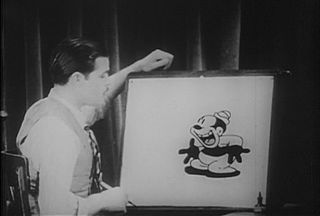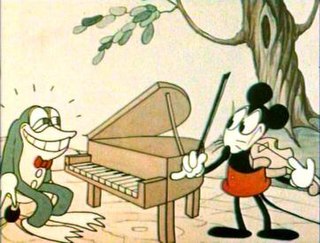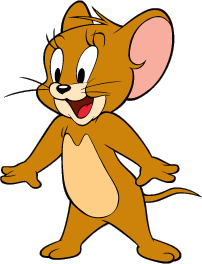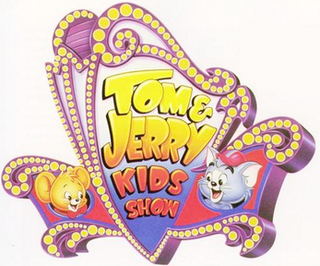Silly Symphony is an American animated series of 75 musical short films produced by Walt Disney Productions from 1929 to 1939. As the series name implies, the Silly Symphonies were originally intended as whimsical accompaniments to pieces of music. As such, the films usually did not feature continuing characters, unlike the Mickey Mouse shorts produced by Disney at the same time. The series is notable for its innovation with Technicolor and the multiplane motion picture camera, as well as its introduction of the character Donald Duck making his first appearance in the Silly Symphony cartoon The Wise Little Hen in 1934. Seven shorts won the Academy Award for Best Animated Short Film.

The golden age of American animation was a period in the history of U.S. animation that began with the popularization of sound synchronized cartoons in 1928 and gradually ended in the 1960s when theatrical animated shorts started to lose popularity to the newer medium of television. Animated media from after the golden age, especially on television, were produced on cheaper budgets and with more limited techniques between the 1960s and 1980s.

Fleischer Studios was an American animation studio founded in 1929 by brothers Max and Dave Fleischer, who ran the pioneering company from its inception until its acquisition by Paramount Pictures, the parent company and the distributor of its films. In its prime, Fleischer Studios was a premier producer of animated cartoons for theaters, with Walt Disney Productions being its chief competitor in the 1930s.

Rudolf Carl "Rudy" Ising was an American animator best known for collaborating with Hugh Harman to establish the Warner Bros. and MGM Cartoon studios during the early years of the golden age of American animation. In 1940, Ising produced William Hanna and Joseph Barbera's first cartoon, Puss Gets the Boot, a cartoon featuring characters later known as Tom and Jerry.

Betty Boop is an animated cartoon character designed by Grim Natwick at the request of Dave Fleischer. She originally appeared in the Talkartoon and Betty Boop film series, which were produced by Fleischer Studios and released by Paramount Pictures. She was featured in 90 theatrical cartoons between 1930 and 1939. She has also been featured in comic strips and mass merchandising.

Flip the Frog is an animated cartoon character created by American animator Ub Iwerks. He starred in a series of cartoons produced by Celebrity Pictures and distributed by Metro-Goldwyn-Mayer from 1930 to 1933. The series had many recurring characters, including Flip's dog, the mule Orace, and a dizzy neighborhood spinster.

Famous Studios was the first animation division of the film studio Paramount Pictures from 1942 to 1967. Famous was established as a successor company to Fleischer Studios, after Paramount seized control of the aforementioned studio amid the departure of its founders, Max and Dave Fleischer, in 1942. The studio's productions included three series started by the Fleischers—Popeye the Sailor, Superman, and Screen Songs—as well as Little Audrey, Little Lulu, Casper the Friendly Ghost, Honey Halfwitch, Herman and Katnip, Baby Huey, and the Noveltoons and Modern Madcaps series.

Gerald Jinx "Jerry" Mouse is a fictional character and one of the two titular characters in Metro-Goldwyn-Mayer's series of Tom and Jerry theatrical animated short films and other animated media, usually acting as the protagonist opposite his rival Tom Cat. Created by William Hanna and Joseph Barbera, Jerry is an anthropomorphic brown house mouse, who first appeared as a mouse named Jinx in the 1940 MGM animated short Puss Gets the Boot. Hanna gave the mouse's original name as "Jinx", while Barbera claimed the mouse went unnamed in his first appearance.
Tom and Jerry is an American animated media franchise and series of comedy short films created in 1940 by William Hanna and Joseph Barbera. Best known for its 161 theatrical short films by Metro-Goldwyn-Mayer, the series centers on the rivalry between the titular characters of a cat named Tom and a mouse named Jerry. Many shorts also feature several recurring characters.
The Van Beuren Corporation was a New York City-based animation studio that produced theatrical cartoons as well as live-action short-subjects from the 1920s to 1936.

Joseph Roland Barbera was an American animator and cartoonist, best known as the co-founder of the animation studio Hanna-Barbera.
Color Classics are a series of animated short films produced by Fleischer Studios for Paramount Pictures from 1934 to 1941 as a competitor to Walt Disney's Silly Symphonies. As the name implies, all of the shorts were made in color format, with the first entry of the series, Poor Cinderella (1934), being the first color cartoon produced by the Fleischer studio. There were 36 shorts produced in this series.

Tom & Jerry Kids is an American animated television series co-produced by Hanna-Barbera and Turner Entertainment Co., and starring the cat-and-mouse duo Tom and Jerry as toddlers. It premiered on Fox on September 8, 1990, airing as the first program of the children's programming block, Fox Kids, and was the second Tom and Jerry TV series to be produced by Hanna-Barbera following The Tom and Jerry Show in 1975.
Daniel Campbell Gordon was an American storyboard artist and film director who was best known for his work at Famous Studios and Hanna-Barbera Productions. Gordon was one of the first famous film directors. He wrote and directed several Popeye the Sailor and Superman cartoons. Later in his career, he worked on several cartoons featuring Yogi Bear, Huckleberry Hound, and many others. His younger brother, George Gordon, also worked for Hanna-Barbera.

Puss Gets the Boot is a 1940 American animated short film and is the first short in what would become the Tom and Jerry cartoon series, though neither are yet referred to by these names. It was directed by William Hanna and Joseph Barbera, and produced by Rudolf Ising. It is based on the Aesop's Fable, The Cat and the Mice. As was the practice of MGM shorts at the time, only Rudolf Ising is credited. It was released to theaters on February 10, 1940, by Metro-Goldwyn-Mayer.
This is a complete list of the 166 shorts in the Tom and Jerry series produced and released between 1940 and 2021. Of these, 162 are theatrical shorts, one is a made-for-TV short, one is a two-minute sketch shown as part of a telethon, and two are special shorts released on HBO Max.

The Metro-Goldwyn-Mayer cartoon studio was an American animation studio operated by Metro-Goldwyn-Mayer (MGM) during the Golden Age of American animation. Active from 1937 until 1957, the studio was responsible for producing animated shorts to accompany MGM feature films in Loew's Theaters, which included popular cartoon characters Tom, Jerry, Droopy, Butch, Spike, Tyke, and Barney Bear.

The Tom and Jerry Spotlight Collection is a series of two-disc DVD sets released by Warner Home Video. Originally planned as an uncensored, chronological set, the issued Spotlight Collection sets include selected Tom and Jerry shorts on each volume. Volume 1 was released on October 19, 2004, Volume 2 on October 25, 2005, and the third and final volume on September 11, 2007. On October 15, 2019, the set, which consists of 4 discs, was repackaged with some errors fixed.

Popeye the Sailor is an American animated series of short films based on the Popeye comic strip character created by E. C. Segar. In 1933, Max and Dave Fleischer's Fleischer Studios, based in New York City, adapted Segar's characters into a series of theatrical cartoon shorts for Paramount Pictures. The plotlines in the animated cartoons tended to be simpler than those presented in the comic strips, and the characters slightly different. A villain, usually Bluto, makes a move on Popeye's "sweetie", Olive Oyl. The villain clobbers Popeye until he eats spinach, giving him superhuman strength. Thus empowered, Popeye makes short work of the villain.

Jerry Beck is an American animation historian, author, blogger, and video producer.














